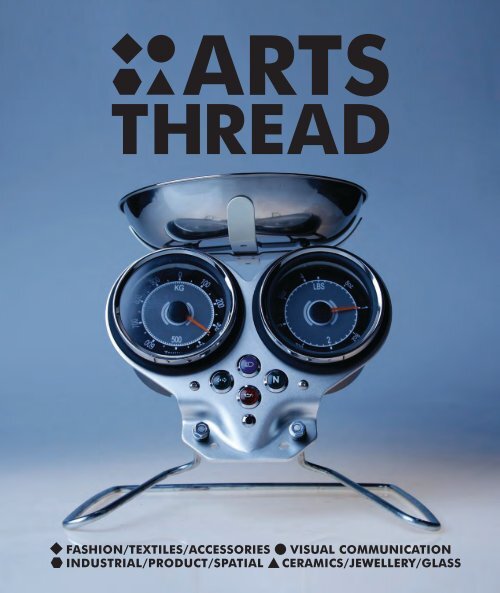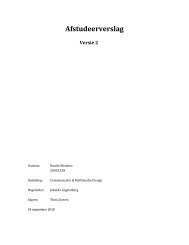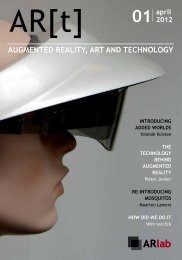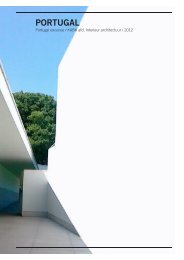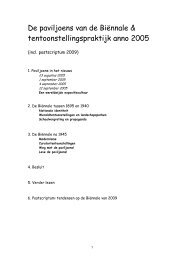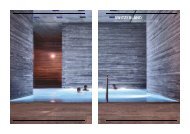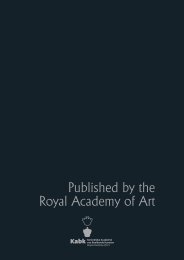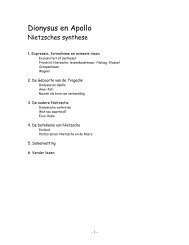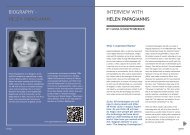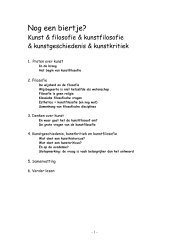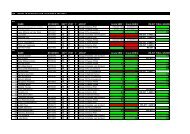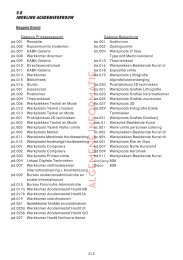FASHION/TEXTILES/ACCESSORIES VISUAL COMMUNICATION INDUSTRIAL ...
FASHION/TEXTILES/ACCESSORIES VISUAL COMMUNICATION INDUSTRIAL ...
FASHION/TEXTILES/ACCESSORIES VISUAL COMMUNICATION INDUSTRIAL ...
You also want an ePaper? Increase the reach of your titles
YUMPU automatically turns print PDFs into web optimized ePapers that Google loves.
Fashion/textiles/accessories visual communication<strong>INDUSTRIAL</strong>/PRODUCT/SPATIAL ceramics/jewellery/glass
ARTSTHREAD.COMCONTENTS07–17Follow the Thread: INTERLINKING THEMES ACROSS DESIGN• ARTS THREAD offers the opportunity to promoteyour own creative courses, showcasing yourgraduates’ portfolios to a global audience.• The site acts as a tool for MA, BA(Hons) and Diplomastudent recruitment, as well as marketing thecourse to Industry for sponsorships and internships.• ARTS THREAD allows you to broadcast live,enabling pre-university students to see lecturesand tours of the facilities wherever they may bein the World.• ARTS THREAD offers you a vehicle for bespokechanging content within our site; allowing youto promote each of your courses in anindividual manner.CONTACT: sales@artsthread.com19–29fashion/textiles/accessories31–41visual communicationCOURSE/PROGRAM PROMOTIONFOR UNIVERSITIES/COLLEGES43–53<strong>INDUSTRIAL</strong>/PRODUCT/SPATIAL55–65ceramics/jewellery/glassUpdated DailyReports on:Graduate shows worldwideDesign events, shows and exhibitionsAnd much more….Creative students and graduates: please update uswith your news—we are here to cover your eventson the ARTS THREAD Blog.Contact: blogcontent@artsthread.com
4 ARTS THREADWELCOME 5Welkom BijARTS THREAD…Bienvenue surARTS THREAD…Welcome toARTS THREAD…Editor-in-chiefKatie DominyArt Direction/DesignMatt BucknallEditorialSelina MealingJackie NortonCalum RossJoyce ThortonSpecial thanks toJainy GansOlivier HayounDirectorsAlex BrownlessKatie DominyPrintHeadley Brotherswww.headley.co.ukContact usTo submit work:art@artsthread.comUniversity/College professionals:uni@artsthread.comIndustry professionals:industry@artsthread.comPress: press@artsthread.comCover imageJohn Doherty, Triumph Lifestyle Accessoriesproject, graham.powell@bcu.ac.ukbiad.bcu.ac.uk/courses/postgrad/maprodd.htmThe views expressed in the magazine do not necessarily represent those of thepublisher. While every effort is made to ensure accuracy, Arts Thread Ltd cannotaccept responsibility for claims made by contributors.This publication is protected by copyright and no part may be reproduced,stored in a retrieval system or transmitted in any form or by any means withoutthe written permission of the publishers.ARTS THREAD is het nieuwe magazine voor decreatieve industrie; professionals, onderwijzers en 14+studenten, die of al een kunst georiënteerde opleidingvolgen of een aanmelding aan een kunst georiënteerdeuniversiteit overwegen.Het magazine en de ondersteunende website,artsthread.com; ’s werelds enige creatieve platform,is dé plek die uniek werk van studenten en alumniwereldwijd tentoonstelt en die altijd up to date info, tipsen trucs van professionals uit de branche publiceert.Het geselecteerde werk wordt puur op basis van decreatieve en artistieke waarde beoordeeld en zal gezienworden door een samengestelde lijst van top industrieprofessionals, die het magazine gratis ontvangen.Wij bezoeken persoonlijk alle afstudeershowsom de denkwijze van nieuwe talentvolle ontwerperste ontrafelen. Wij zijn ervan overtuigd dat dezedesigntrends vaak in alle creatieve disciplines tegelijkzichtbaar zijn en daarom hebben wij de Follow theThread sectie gecreëerd, zodat je kunt zien hoe dezekunst & design vakgebieden in elkaar haken.Verder is het magazine opgedeeld in 4 design groepen;mode/textiel/accessoiresvisuele communicatieIndustrieel /Product/ Interieur Architectuurkeramiek/sierraden/glasDeze 4 geometrische iconen zullen je doorhet magazine heen helpen navigeren.We hopen dat de ontdekkingsreis door het werkvan de getalenteerde ontwerpers, die we hebbengekozen voor dit nummer, je vermaken.En als jij binnenkort ookafstudeert en je ons ookgraag voorziet van informatie en foto’s van jouw project,mail ons dan alstublieft via: art@artsthread.com.ARTS THREAD: een nieuwe, online educatievetool ontworpen om studenten, alumni, universiteitenen organisaties binnen de designbranche, met elkaarte verbinden. Voor het eerst ooit, kunnen studenten,alumni, universiteiten en organisaties wereldwijd metelkaar netwerken, door slechts een paar klikken opde muis.ARTS THREAD est un nouveau magazine pour ceux quiétudient les arts appliqués et le design. Il s’adresse aussibien aux lycéens, aux étudiants en écoles de design oud’universités qu’aux enseignants et aux professionnelsde l’industrie.Le magazine et le site web artsthread.com ontpour but de mettre en valeur les meilleures créationsdes étudiants et des diplômés en arts appliqués et endesign se trouvant en Europe. Ils permettent aussiaux enseignants et aux spécialistes de l’industrie decommuniquer afin d’encourager le développement deces matières.Les travaux sélectionnés seront jugésessentiellement sur leurs mérites créatifs et artistiques.Ils seront vus par une sélection de professionnelsdu plus haut niveau de l’industrie, qui reçoivent lemagazine à titre gracieux.Nous visitons toutes les expositions des projets dediplômés afin de vous informer des tendances actuellesdes nouveaux designers. Nous pensons que cestendances se manifestent d’une manière transversaledans tous les secteurs des arts appliqués et du design.Afin d’être régulièrement informé, nous avons créé larubrique Suivre le Fil (Follow the Thread) où l’on peutvoir comment se croisent et se mélangent les créationset les travaux des arts appliqués et du design.La rubrique “design & arts appliqués” a été répartie enquatre parties:Mode/Textiles/AccessoiresLa communication visuelleINDUSTRIE/PRODUIT/ESPACECéramique/bijouterie/verreVous retrouverez régulièrement ces quatre icônesdans le magazine pour faciliter votre navigation.Nous espérons que vous apprécierez de découvrirle travail d’un groupe de designers si talentueuxprésents dans cette édition.ARTS THREAD est un réseau en lignecommunautaire et pédagogique conçu pour connecterles étudiants, les diplômés, les universités et l’Industrie,exclusivement dans le domaine du design. Pour lapremière fois, les étudiants en art, les universités, lesindustriels et les écoles peuvent travailler en réseau àtravers le monde en quelques clics.Arts Thread is a new magazine for those involved inthe study of the creative arts, from 14+ studentsconsidering going to university or college through tolecturers and industry professionals.The magazine and its supporting websiteartsthread.com: the world’s only creative graduate website,have a commitment to be a platform to showcase the bestwork from students and graduates of creative art and designworldwide and to publish information from lecturers andindustry specialists that encourages a greater interest inthe subject.The work chosen will be judged purely on creative andartistic merits and will be seen by an edited list of top industryprofessionals, who are sent magazines free of charge.We personally visit all the graduate shows to showyou how new designers are thinking. We believe that thesedesign trends often appear across all the creative arts, sowe have created our Follow the Thread section where youcan see how the various strands of art & design interlock.For the rest of the magazine we divide the creative arts into4 groups:fashion/textiles/accessoriesvisual communication<strong>INDUSTRIAL</strong>/product/SPATIALceramics/jewellery/glassYou will find these 4 geometric icons throughoutthe magazine to help you navigate more quickly.We hope you enjoy discovering the work of the talenteddesigners we’ve featured in this issue. If you are a graduatingsoon and would like to send us information and images,please do contact us on art@artsthread.com.ARTS THREAD is a new online educational tooldesigned to connect students, graduates, universities andIndustry, exclusively within the field of design. For the firsttime ever, creative students, universities, industries andschools can network worldwide—with just a few clicks ofthe mouse.
2011the source of newtextile design talentFollowMIXED TREND 7theFIRST VIEW LONDON 13 th –15 th July 2011SUPPORTED AND ENDORSED BY INDUSTRYFOUNDATION SPONSORSTHE CLOTHWORKERS' FOUNDATIONTHE DRAPERS' COMPANYMARKS & SPENCERSANDERSON ART IN INDUSTRY TRUSTWOOLMARK INTERNATIONALPRIZE SPONSORSThe Clothworkers’ FoundationLiberty Art FabricsLyle & ScottPantone EuropePentland Group plcSanderson Art in Industry TrustThe Triangle Building,Chelsea College of Art & Design, LondonINDIGO PARIS 20 th –22 nd September 2011Hall 5, Première Vision Pluriel,Parc d'Expositions de Paris Nord, VillepinteMAJOR SPONSORSBURBERRYCONFINDUSTRIA COMOTHE COTTON INDUSTRY WARMEMORIAL TRUSTDIANE von FURSTENBERGGARFIELD WESTON FOUNDATIONTHE HABERDASHERS’ COMPANYINDIGOJAEGERTHE LAURA ASHLEY FOUNDATIONNEW LOOKSPONSORING PUBLISHERSARTS THREADCOLLEZIONI TrendsVIEW PublicationsSUPPORTERSAquascutumBodenDonna KaranFriends of TexprintGiles DeaconHobbsLord Barnby’s FoundationMakower Prize FundMiroglio Textile Srl/UlmiaPaul SmithRatti SpAR.A. Smart LtdSalvatore Ferragamo Italia SpASwiss Textile FederationUKFT TextilesWeisbrod-Zuerrer AGThe Worshipful Company of WeaversWorshipful Company Of World TradersACCESS, REVIEW, BUY ANDCOMMISSION WORK FROM ASELECTION OF OUTSTANDINGCREATIVE DESIGNERS, NEWGRADUATES OF UK COLLEGESIN-KIND SUPPORTERSChelsea College of Art & DesignD&AD Talentpoole-styleGallant Macmillan LLPMesse Frankfurt (HK)Mode InformationR.A. Smart LtdThe Textile InstituteToray Textiles Europe LtdWGSNFOR MORE INFORMATION CONTACTinfo@texprint.org.ukwww.texprint.org.ukTEXPRINT ® REGISTERED CHARITY NO: 1000411ThreadIn this section, we follow the thread of ideas coming through inrecent graduate work, from form and function through to materialsand colour.We believe that strong ideas grow from a broad awarenessof what’s happening in all sectors of the creative arts. Greatcollaborations and fresh thoughts spring from studying the work ofpeople designing for other industries, often one completely differentfrom your own.The strongest themes often appear across all the creative arts, sowe have created our Follow the Thread section where you can see howthe various strands of art & design interconnect.
8 MIXED TREND MIXED TREND 9MODEL EXPLANATIONSScientific study / Mobiles on wire / Geometric / Visual metaphor / 3D formsTHE INSTITUTE FOR DIGITAL BIOLOGYGROW YOUR OWN BUBBLES‘Within my practice, I explore the potentialof CAD, haptics and rapid prototypingprocesses to create entirely new formsbased on nature; subverting a process thatis fundamentally mathematical to createobjects that appear to be completely organic.‘In the STL file format, 3D forms arestructurally based on a mesh of trianglesmathematically defined by algorithms.I control the degree of deformation bymodifying the resolution of the mesh(number of triangles). Through thisprocess, I reflect on the integration of theconstruction of the interior and exterior:and the unique opportunities offered bythe haptic interface in the final object.’‘The Institute for Digital Biology researchesthe next step in the evolution of theInternet, introducing a system of life anddeath (and thus Survival of the Fittest) foronline applications. Online applicationswill evolve into living creatures; websiteswill evolve into physical beings that needattention for survival and these new specieswill live in symbiosis with humans as themost intelligent entities on earth.‘The models are mostly made out ofpolystyrene, bits of electronic wiring andvarious other materials, serving as a visualmetaphor for the Internet, through which itwas easier for me to illustrate my view onthe Internet and its relationship to humans.’Walewijn den Boer, Royal Academy of Art, The Haguewalewijndenboer.nl/instituut/labviewFarah Bandookwala, Edinburgh College of Artfarahb.comSENSORY SOUND OBJECT‘My current work is a family of sophisticatedinteractive sensory sound objects. I takeinspiration from my hobbies and childhood,from music, musical instruments, sea life,cells, microorganisms and toys.‘These objects are beautifully hand craftedusing processes that include metal spinningand powder coating. My joyful pieces aredesigned to be held and explored; blowinginto them causes them to emit unexpectedand sometimes ‘silly’ sounds.’WIRE FRAMES‘Wire Frames is a radio assemble made fromplastic castaway scraps and a wire frame.’The curved shape of the openwork modelis reminiscent of a small creature, a dog,and reminds one of the painting used byHis Master’s Voice, the early 20th centuryrecord label, featuring a dog listening to agramophone.Koby Sibony, Bezalel Academy of the Arts, Jerusalemsites.google.com/site/thinkinghands2011Photo: Oded AntmanMaddie Harris, BIAD School of Jewellerymaddieharris.co.uk
12 MIXED TREND MIXED TREND 13HANDFORMEDGEOMETRYMark of handwork / Natural grains / Fifties aesthetic / Subdued palette / Satisfying617D*W‘When I made 617D*W I was working atan office chair company as a developer.Everyday I was thinking What iscomfortable? —I saw a lot of chair designs.‘Then I noticed that round/curves givespeople a ‘comfortable’ feeling and flat/sharp edges give an ‘uncomfortable’impression. However, many chairs aredesigned without paying much attention tothe human figure, even though they mightappear comfortable. So wanted to design achair that does quite the opposite. Lookingflat and angular but being comfortable whileused. It is also stackable.’Yuya Ushida, Design Academy Eindhovenyuyavsdesign.comSKUE‘Skue is an elegant table made from walnut,expressing playful restraint through coloursof satin finished lacquer. Architecturalgeometric panels come together to createan asymmetric form, casting unexpectedshadows that interlay within the negativespace. Thin edges taper to an apex, addingstrength and concealing the joinery.Juxtaposing multiple Skue tables enhancesthe movement of contour lines and dynamicshadows that complement each other.’David Kim, Art Center College of Design, PasadenaCROSSING LINESTHE GRID PROJECT‘This series of posters was the result of researchinto the rules of the typographic grid and the ideasbehind deconstructivism in graphic design. Thespecific main ideas in Josef Müler-Brockmann’smodernist manifesto were paired with each of theirrelating opposities from deconstructivism, formingillustrations that explain the relation between twocounterparts. The design took its starting pointfrom the grid used for Josef Müler Brockmannsbook ‘Grid systems in Graphic Design’.Peter Orntoft, The Danish Design Schoolpeterorntoft.com‘My current work is a collection of custommadeoak frames wrapped in overlappingand intersecting layers of viscose rayonyarn, chosen for their highly reflectiveproperties. The effect of light upon thework creates a constantly changing visualexperience, encouraging viewers to lookat each piece from numerous angles anddistances. The inspiration for this projectderives from the observation of crossing,intersecting and layering of lines, colourand form in the urban landscape and howtheir visual qualities are affected by themovement of the observer.’Maryrose Watson, Chelsea College of Art & Designmaryrosewatson.co.ukPhoto: copyright Maryrose Watson 2011
14 MIXED TREND MIXED TREND 15NATURAL TECHNIQUESFOR SYNTHETICSHandwork on industrial materials / Individual / Sustainable / DIY aestheticMAKE&BREAK‘The Make&Break stools form a part ofthe Make&Mold series—a process-basedconcept where industrial mould principlesare reclaimed and translated into a DIYprocess. The series is made from recycledpolypropylene granulate and the processmakes it possible to create individualobjects within the basic mould shape,meaning no two pieces are identical.’Rutger de Regt, Royal Academy of Art, The Haguerutgerderegt.comFOAM PANORAMA‘Foam Panorama is a sculptural workcreated as a site specific, real timeperformance. The work aims to capture/record/manifest a specific moment ofattention, using the audience and expandedfoam as a medium. A hot wire is stretchedfrom a fixed point in the centre of the foamblock, while the other edge is ‘scanning’the radial landscape around it. The wire isslicing through the EPS foam block, leavinga morphological trace of silhouettedfigures.’ Sculpture without the chisel.Yoav Reches, Royal College of Artyoav-reches.comPRECIOUS WASTE‘My goal was to alter plastic shopping bagsin a way that would make the material lastlonger, while remaining recyclable. This ledto ‘Precious Waste’, a textile made entirelyout of used plastic shopping bags that werespun into yarns and then woven. The plasticshopping bag can be transformed by purehandwork into a beautiful and strong material,suitable for a wide range of purposes. Whenthis textile is eventually worn out it can still berecycled in the conventional way, because it’snot a mixed material and can become a newproduct once again.’Michelle Baggerman, Design Academy Eindhovenbureaubaggerman.nlPhoto: copyright Michelle BaggermanTURNING YTONG‘This research arose from experiments withYtong (autoclaved cellular concrete) and itsuse in industry. Bowls became the chosen formfor my experiments. Foremost in my mindwere the lightness of Ytong, its aesthetics andthe elegance of its aeration and colour.‘I wanted to find a way to exploit the insulationproperties of the material - for example,serving hot food so that the outside of the dishcan be comfortably held in one’s hand.‘In terms of form, I sought to design thickbowls, with wide lips in order to suggest weightand volume and create surprise when one liftsthe dish and discovers its lightness. The finenessof the lip and edges is intended to accentuatethe material’s delicacy and fragility.’Maia Halter, Bezalel Academy of the Arts, Jerusalemmaiahalter.comPhoto: Oded Antman
16 MIXED TREND MIXED TREND 17RECLAIMED METALVictorian industry / Recycled / Enduring / PlayfulTALL BLACK HANDLE‘The work has grown from an interest in the18th century surgical tools in museums suchas the Wellcome Collection. The beautifulshapes and handles of these knives arefascinating, but because of their purpose,repulsive. From this curiosity my interest inknives has developed.‘There is a history of industrially producedceramic, mostly porcelain handles for cutlery.I work with found knife blades and constructnew, sculptural ceramic handles. Each handleis designed to suit a specific blade, so eachone is handmade and unique. The forms areinviting to hold but impracticable to use.’DOMESTIC AIR CONDITIONERA trumpet and copper piping create adomestic air conditioning unit, keeping the aircool by means of a rotary fan and ice cubesin a glass bowl.Marianthi Vezertzi, Kingston Universitymvezertz@gmail.comLaura Plant, Camberwell College of Artslauraplant.co.ukSUBDIVISION SERIES‘My intent is to instil a preciousness in thebanal via its material transformation, aswell as to utilise jewellery’s role as socialsignifier in order to challenge the public’spreconceived ideas of both the practice ofcraft and its aims.’Rachael Colley, Royal College of Artrachaelcolley.comCOGS & WHEELS‘I take inspiration from the structures andforms of clocks and pocket watches and amfascinated by the shapes and contours foundwithin shells. I have created a collection usingCAD built components that allow me to varythe design easily.’Evie Simm, BIAD School of Jewelleryeviesimm@ymail.com
GRADUATE <strong>FASHION</strong> WEEKCongratulations to our 2010 River Island Gold Award Winner Rebecca Thomsonfrom Manchester Metropolitan University and all the other award winners,finalists and exhibitors.Working to promote the very best graduate fashion design talent from both UK andInternational universities/colleges to the creative industries worldwide.<strong>FASHION</strong>/<strong>TEXTILES</strong>/<strong>ACCESSORIES</strong> 19NATURAL GROWTHHair, fur and feathers provide inspiration to create using new materials and new orrevived techniques that mimic the appearance of our soft protective coatNurturing the talents of today’s young, creative innovators, so that tomorrow’sdesign industries can continue to play a major role in the economy of the UK andthe rest of the world.Photo: Simon ArmstrongGFW.ORG.UKANIQUE NOORDMAN—A TUFT OF HAIRDESIGN ACADEMY EINDHOVEN‘Bouncy curls, to touch andstretch out. Voluminous afrohair, you’d like to dive into.‘One long braid reveals ahundred knots, a braided finishededge, twisted knots….Dip dyeingof strands, waxing and modeling.Waffled crimped wig, thick locks,irregular dreadlocks.‘A collection of carpet ideas,inspired by hair, hair fashionand hairstyles —as a forecast forcarpets and yarns.’aniquenoordman.nl Photo shoot & styling:Sophie Duran & Anne Smolders
20 <strong>FASHION</strong>/<strong>TEXTILES</strong>/<strong>ACCESSORIES</strong><strong>FASHION</strong>/<strong>TEXTILES</strong>/<strong>ACCESSORIES</strong> 21LÆRKE HOOGE ANDERSEN—THE SYNTHETICKINGDOM: BARKFURCENTRAL SAINT MARTINSCOLLEGE OF ART & DESIGN‘The Synthetic Kingdom is afuturistic narrative about theemerging field of synthetics andhow synthetic biology will enableus to create, produce and growmaterial hybrids, in a crossdisciplinaryfield of science, artand sustainability.NOORTJE ZIJLSTRA—GIRS WITH BEARDSWILLEM DE KOONING ACADEMY‘Because women (in general) can’tgrow a beard I wanted to makebeards for them. I did this throughfacial jewellery that’s elegant andfeminine. A beard for me is aboutthe combination of the face, neckand chest. I want to emphasisethese with facial jewellery andclothing. I used metal chains, satinyarn, silk, satin, suede, jersey, wooland leather.’noortjezijlstra.comPhoto: Ninette Schostack‘These flora and fauna hybridsgrow and produce entire newnatural materials, such as overdimensioned structures andtextures that have extraordinarytactile qualities, for example,combining animal fur with thebark of a tree.‘The Barkfur shown is a skinflora that grows from its hostingbody, functioning as a protectivelayer against pollution and hightemperatures. The hair tattoo isgrowing in pattern formations,developed over generations, toserve as an urban landscapecamouflage.’laerkehoogeandersen.com
22 <strong>FASHION</strong>/<strong>TEXTILES</strong>/<strong>ACCESSORIES</strong><strong>FASHION</strong>/<strong>TEXTILES</strong>/<strong>ACCESSORIES</strong> 23CHINESE CRACKERCrackle glaze transformedIRIS VAN DAALEN—GRAPHIC HAIRDESIGN ACADEMY EINDHOVEN‘Hair is stubborn, it goes itsown way.’‘I make jewels of human hair,so it becomes as smooth and flatas a mirror. By putting the jewelson, they blend with your ownhair. These jewels are in controland stay in place forever,like an old picture.‘A new way to capture hair.’irisvandaalen.nlPhoto: Femke ReijermanARTS THREAD speaks to London College of Fashion MAgraduate Wei Wang about her series of tactile ceramicevening bags in Chinese crackle glaze.‘I am interested in both handbag and jewellery design, so Ithought it would be a good idea to combine these two objects into a‘jewellery bag.’‘After doing a lot research, the evening bag came to mind. Onone hand, it is precious, on the other hand, as a small but importantfashion icon, an evening bag’s culture and identity functions arebecoming more and more important.‘I found ceramics had the right feminine character—elegant,unique, unpredictable and growing more precious as time passes.These elements match the evening clutch perfectly, no matter whatfunction or social status.‘Furthermore, I specifically used Chinese crackle glaze. Thecrackle pattern will continuously crack so that the ceramic displaysa new appearance over time. I like this idea very much. It is likecarrying an elegant bag that incorporates the glorious past with thepresent fashionable outlook.‘I used the most traditional Chinese technique of handmadeceramics with a contemporary metal frame. You can see the contrastfrom the techniques. It looks very easy and simple, but every tinyproblem would lead to a fatally wrong result.‘I did some changes to my design and developed some ceramictechniques after discussions with ceramics makers and metalprofessionals. Ceramics is not like metal or plastic, you can makeany shape what you want. The process itself was an arduous onegiven that it was a basically trial and error as well as dusting downthe clay ash and trying and trying again.‘Therefore, this collection is exclusive and 100% handmade.Handmade gives a luxury and unique touch to the product. Mypersonal ambition is to keep the style unique. Every piece is a piece ofart in itself, as were the ceramic pieces from hundreds of years ago.’wwei318@gmail.comPhotos: Tom Mulvee, Model Agency: immmodels.com
24 <strong>FASHION</strong>/<strong>TEXTILES</strong>/<strong>ACCESSORIES</strong><strong>FASHION</strong>/<strong>TEXTILES</strong>/<strong>ACCESSORIES</strong> 25MODERN CRAFTNew directions for mens knitwearTEXT JOYCE THORNTONMens knitwear has long conjured upvisions of cosy, boring and slightlysad garments; perhaps warm andcomforting, but devoid of style. Conventionaland stagnant are words that spring to mind,but a new wave of designers are challengingthis state of affairs and thankfully breathingnew life into this age old craft.Rising Danish talent Mette MarieKrarup Bertelsen is amongst the vanguardof these influential young members. Hermens knitwear collection was inspired byher primary research conduced on the NewYork Subway system. Mette Marie graduatedin 2010 from Kolding School of Design withan MA in Fashion Design. While in NewYork riding on the subway trains, she filmedactivity via a video camera kept in onesingle position. The resulting film revealedmany contrasts with sections that becameenigmatic blurred snapshots populatedwith fleeting, mysterious characters. Shethen used the film footage as her inspirationfor exploring the relationship betweenstillness and movement, light and dark. Herresulting knitwear is created using mainlyorganic cottons, with the oversize cardigan(pictured) produced by first creating 1cmstrips on a digital machine and then handknitting the strips using size 15 needles.childhood fantasy, Onez creates dramaticdesigns for both men and women. Her shapesare created from her imaginative use ofmaterials, textures and colour. Loops, tassels,fringing and plaits are intermingled with netand feathers to create her distinctive pieces.At Design Indaba this February, we cameacross the work of Laduma Ngxokolo, whoseknitwear is based on traditional beadworkdesigns of the Xhosa from South Africa’sEastern Cape. The Xhosa initiation ceremonyfor teenage boys includes the symbolicpresentation of a new ‘mens’ outfit andinstead of the Western labels currently invogue, Laduma has designed The ColourfulWorld of the Xhosa Tribe, a range of knitsusing traditional Xhosa colours and patterns,such as the zig-zag, arrow and diamond.In marked contrast to Laduma’s colourfulexuberance, another young Scandinaviandesigner, Mille Marie Jensen has a beautifullyrestrained handwriting. Mille concentrateson classic structures and subtle details tocreate her clean, contemporary shapes. Herinspiration for her collection entitled TheElusive Man was derived from ‘the thoughtfulmelancholy and the poetic expression in thespirit of the Scandinavian man’. Her missionwas to focus on subtlety and understatementand her delicate, sensitive touch willundoubtedly create a firm following.Above Onez Lau, Central Saint MartinsCollege of Art & Design, Photo: jeff-hahn.comOpposite left Mette Marie KrarupBertelsen, Kolding School of Design,bleansjevovits.dkOpposite top Jennie Siljedahl, The SwedishSchool of Textiles, info@jenniesiljedahl.com,Photo: Robert ElmengardOpposite bottom Laduma Ngxokolo,Nelson Mandela Metropolitan University,Photo: Astrid Arndt, stylist Maran CoatesOpposite right Mille Marie Jensen,Kolding School of Design, millejensen.com,Photos: kristianholm.comIn the UK, Onez Lau’s madcap creativeexuberance was revealed in a crowdpleasingknitwear collection at the CentralSaint Martins BA (Hons) graduate show inLondon in early June 2010. Visitors werewowed by her direct and youthful approach,which generated smiles on the front rowand beyond. Her extravagant oversizedshapes, animal imagery and a great, bold andirreverent approach created a definite buzzwhich has won her many fans. Inspired byNational Geographic photography mixed withJennie Siljedahl showcased her graduatecollection at both Stockholm and LondonFashion weeks, as part of The SwedishSchool of Textiles (University of Boras).Jennie mixes hand-knits, some usingcopper yarn with extravagant drapingand more tailored pieces for her dramaticand uncompromising mens collectionentitled Control Me as I Control You. Partbohemian romantic, part futuristic warrior,Jennie has a singular aesthetic. Accessoriesincluded some great neckpieces constructedfrom discarded and dismantled hardwareincluding large metal hinges, spotlightfittings and timers.These young designers are just thetip of the iceberg of talent that is set oncatapulting a cosy and genteel craft into the21st century.
26 <strong>FASHION</strong>/<strong>TEXTILES</strong>/<strong>ACCESSORIES</strong><strong>FASHION</strong>/<strong>TEXTILES</strong>/<strong>ACCESSORIES</strong> 27INSPIRED BY LIGHTRupert Newman’s pioneeringwork fuses image, light, sound andspace to bring surface pattern to lifeand immerse and involve the viewer inthe spectacle. Rupert’s graduation showcaptivated many visitors at the Royal Collegeof Art (RCA), where he completed his MA inTextiles last year. Decorative fabric panels wereprojected with light, animation and sound,creating mesmerising effects. Rupert aims to‘create unusual moods and atmospheres, whichhave a direct influence on the viewer’. He says,‘I not only aim to stimulate and bombard thesenses with a variety of colours, textures, shapesand sounds, but also to provide the viewer withthe ability to choose, control and manipulatethis ‘palette’ with both predetermined andunpredictable material’. Rupert’s singularapproach challenges the accepted artist/spectator relationship, as he explains, ‘I want togive the element of control back to them. I wantthem to explore the boundaries of my work intheir individual ways’.Four exciting new textile design talents—all exploring a shared illuminating passiontext Joyce ThorntonThe recreational and therapeuticbenefit of his work is clear and hisinstallations have been well received bythe public, being shown at music festivals,nightclubs and galleries. He is alsobeginning to explore how his work mightbe harnessed in sensory rooms, or play arole in product showrooms, or as windowinstallations. Rupert is also currently inthe process of planning an exciting newexhibition, to be held in Brixton, Londonlater this spring. The exhibits plannedinclude a variety of contrasting fabricsand light projections all accompanied byindividual sounds, heard though wirelessheadphones.Central Saint Martins (CSM) MATextile Futures course has also nurturedsome of the most exciting emergingtextile designers. Siwen Huang’s graduatecollection is entitled Light Montage. Thedesigner told us, ‘I wanted to use lightcreatively, as a raw material, in order to adda sense of fantasy and magic to my designs.I wanted to harness magical colour createdthrough structural surfaces…..intangible yetvisible. Light is around us day and night,changing our perceptions.’Siwen’s work incorporates three mainelements: light, shade and colour. Usinglaser cutting and hand finishing on flexibleand reflective materials, Siwen has createda number of three dimensional opticalsurfaces. ‘The finished pieces distort andredirect light as it hits the surface, creatingillusory and ambiguous effects’. Siwen’sLight Montage is a soft partition designed tobe used in any interior space and like RupertNewman, the designer is interested ininteractivity, giving viewers some control tocreate the pattern they want. Light MontageIII uses four layers of sliver film to buildup numerous pyramids, so that the fabricresembles cold, sharp metal when seen at adistance, but when touched the material issurprisingly malleable.Also graduating from CSM’s MATextile Futures course, Chai Young Leesays of her Optics and Mirrors project,‘Light and reflection are amongst my greatinspirations. I have been interested in theway light reflects or how it is sparkles onwater. The reflections produce repetitiveimages and create a mysterious vision—between reality and fantasy.’Chai explains further, ‘Mirrors have longoccupied an interesting area in our lives,beliefs and dreams. Personally, I find themvery special objects, because I`ve comeacross them in many fairytale stories sincechildhood. Fairytales that have a mirrorplaying a key role in the story are fascinating.If you take Snow White and the Snow Queen,for example, the queen has a mirror that cancommunicate with people. In fairytale storiesa mirror is an object which allows peopleto broaden their dreams and imagination. Ihave tried to create an optical surfaces whichcreates a new type of emitting light thatcan influence our imagination and transmitdifferent sensations to us. The surfaces createa spectacular illusion of hundreds of patternsthat seemingly have no end. Moreover, thereare magical quality about it by simply turningthe light ON and OFF. It becomes a regularmirror when the light are turned off. It meansthese products can function as both mirrorsand decorative lighting.’Jenna Gibson is another of 2010’s RCAtextile graduates, who was inspired by light,but in a very different way. Jenna’s fabricsare fashion forward with a futuristic edge.Her distinctive style has attracted someexciting recent commissions, includingdesigning for Hugo Boss. Jenna flew outto meet with the brand’s design team inStuttgart and her commissioned designsmake up the main print story of the Spring/Summer 2012 Hugo Womenswear line.The transition of light and architectureinspired Jenna to use subtle gradationsof colour to create the illusion ofsculptural form. For her most recenttextile collections, her inspirations havedeveloped and she is currently workingto mix both traditional screen and digitalprinting. Jenna’s abiding passion though,remains with screen printing. She told ARTSTHREAD, ‘I really love screen printing, as Ifeel it adds depth and texture to the fabric;I find the craft of the printing process reallyexciting and fulfilling.’These new textile designers arechallenging the accepted frontiers of theircraft, each following their own distinctivepaths, all illuminated by the sharedinspiration of light.Opposite top Rupert Newman, Royal College of Art,rupertnewman.comOpposite bottom Siwen Huang, Central Saint MartinsCollege of Art & Design, siwenhuang.comLeft Chai Young Lee, Central Saint Martins College ofArt & Design, chaiyounglee.comAbove Jenna Gibson, Royal College of Art,jennagibson.co.uk Photo Stuart York
28 <strong>FASHION</strong>/<strong>TEXTILES</strong>/<strong>ACCESSORIES</strong><strong>FASHION</strong>/<strong>TEXTILES</strong>/<strong>ACCESSORIES</strong> 29Below and Opposite bottomVesna Pesic, London College ofFashion, vesnahats@gmail.comPhoto below: Nina Sologubenko,Photo opposite: Ashley LowOpposite top Borre Akkersdijk,Design Academy Eindhoven,byborre.com Photos: CatherineHermans, Make-Up & Hair: DanusiaGlowicka, Models: Marina & LoraineOpposite centre Nora Juliette,ABK Maastricht, norajuliette.tumblr.com Photo Valentina VosHARD HATSMillinery with a harder edgeTEXT SELINA MEALINGThroughout history hats have played afunctional and fashion role in men’sand women’s wardrobe. However,for many, hats conjure up images of RoyalAscot and other very formal affairs withvery pretty, very extravagant head pieces.Gradually hats have featured less in oureveryday dress, seen more in militaryuniform than down the runway.Yet, three designers are trying tochange the way we look at hats. They areBorre Akkersdijk, Nora Juliette and VesnaPesic. Each designer has their uniqueapproach to millinery, but each demonstratean unexpected use of leather.Vesna Pesic is a London College ofFashion MA Fashion Artefact graduate andher collection, entitled Poetry In Pose, isconcerned with ‘questioning the traditionaluse of the materials and the acceptedassociations of beauty and usefulness.’ Hersculpted leather head pieces are designedfor men and women. Vesna explains:‘Leather in itself has a symbolic meaningas a second skin so it was an obviouschoice. I employed different techniquesto make my designs, using leather as ifit were fabric, draping it, or free-formingit, but also as if it were clay to give it asculptural quality. I used one of the ancienttechniques for leather called ‘Cuir Bouilli’,which literally translated from Frenchmeans ‘boiled leather’. The purpose is toharden the leather. This way I was capturingthe movement, the moment. All the leatherwas dyed by me as through this I could addanother dimension. I have a strong beliefin an instinctual approach to working,combined with reflection.’Similarly, Borre Akkersdijk, a graduateof the Design Academy Eindhoven, hascreated some very simple and strikingpieces for his series of hats inspired by‘children who put all kinds of pots andpans on their heads’. The hats, madefrom beautiful tan leathers and dark felts,incorporate the child-like quality, but withan added sophistication, creating veryluxurious pieces of headgear.In contrast to the previous twodesigners, Nora Juliette, a fashion graduateof ABK Maastricht, presents a morefunctional collection entitled Let It All HangOut. Nora has created some remarkablywearable pieces that have ‘a need to makepeople curious and have to search for thedetails’. Inspired by the leather caps wornby falcons used in hunting, the use of deeptan and black leather as well as soft whitewool in her designs gives the collection aretro-aviation appeal.
<strong>VISUAL</strong> <strong>COMMUNICATION</strong> 31Talented People.Great Careers.DESIGNER FOODThe imaginative use of graphic design to inform and educate peopleon the subject of food and health issuesTechnologyStrategyProjectManagement& ProducersCreative& DesignClient Serviceswww.cogsagency.comFLORIKE MARTENS—WAT ETEN WE VANDAAG?FISH IN THE OVENDESIGN ACADEMY EINDHOVEN‘Food is a much discussedsubject these days. We want toeat healthier, but we forget totake the time for it. Cooking istaken over by the microwave.‘The little movies about howto make a dish are to inspirechildren and their parents, butalso single men and women,to make their own food again.It takes just half an hour, butby cooking your own mealyourself, you also take time foryourself to de-stress. You chooseyour own ingredients and whatsize you want to make it. Andyou flavour the food the way youlike it. Cooking isn’t that hard,it’s fun!’florikemartens.nl
32 <strong>VISUAL</strong> <strong>COMMUNICATION</strong> <strong>VISUAL</strong> <strong>COMMUNICATION</strong> 33ALISON THOMSON—THE CHRONIC FACILITYROYAL COLLEGE OF ART‘The Chronic Facility is analternative system for treatingpeople with chronic disease,taking the service rituals andsystem of a restaurant andredesigning it to cater for thisneed. It provides us with alanguage to discuss issues ofliving with disease, treatmentsand diagnosis.‘The Facility uses representationsof people’s diagnosis createdby food models from scientistswhich can be served tocustomers. This speculativeservice has been designed froman inclusive methodology ofworkshops and performances,which have resulted in theredesign of the relationshipbetween patient, clinician andscientist.’Project in collaboration withthe Neuroimmunology Groupat Barts and The London NHSTrust.Final Dish 1: an axon with acell body, with individual nodes(mushrooms).Final Dish 2: a procedure in thesmall vein in the centre of thelesion, similar to a varicose veinin the legs.ANDERS GERNING—SMAGSDOMMERNETHE DANISH DESIGNSCHOOL‘The project is a redesign of thecookery book Smagsdommerne(Arbiters of Taste) by ClausAngelo Brandt and CarstenLunding. Smagsdommerne is anunconventional cookery bookthat does not deal with specificingredients but focuses on thefive basic tastes—sweet, sour,salty, bitter and umami—that,according to Smagsdommerne,make up the foundation for allgood food. In addition, the bookemphasises three basic textures:soft, crisp and juicy.‘I have transformed these fivebasic tastes and three basictextures into colours and shapes,respectively, in the redesign ofthis untraditional cookery book.’Close-up of gooseberry sautérecipe, Close-up of potatoroulade recipe.fortheloveofg.comFinal Dish 3: mice cell culture balls.somehowrelated.co.uk
34 <strong>VISUAL</strong> <strong>COMMUNICATION</strong><strong>VISUAL</strong> <strong>COMMUNICATION</strong> 35MARIJKE TIMMERMAN—WHAT’S FOR DINNERTODAY—THE REAL SIZEOF FOODDESIGN ACADEMY EINDHOVEN‘What’s for dinner today amidstsuch abundance? Our intakeof food—basically the buildingblocks for the body—has longsince ceased to be prompted bya physical need alone. We areconstantly reminded of food bythe things we see around us. Itmakes us graze all day long, withall that this entails.’Marijke Timmerman, designer atthe Dutch graphic design agencyDik&Stijlloos, has researched theway we deal with food, which shefeels is absurd. She has visualisedher findings in a book andposter campaign aimed at youngpeople. ‘What’s for dinner today’reveals contradictions, shattersillusions, and is a wake-up call tothe reader.dik-stijlloos.nlMARCO DE MEL PEDERSEN—MEAT THE FACTSKOLDING SCHOOL OF DESIGN‘According to UN reports thelivestock sector is responsiblefor 18% of all greenhouse gasemissions and therefore one ofthe biggest contributors to globalwarming. Target Group: ModernCity Consumers living in NewYork City (25–55 years old).‘My context is the New YorkCity subway system (Insideand outside subway trains andwithin the subway system ingeneral i.e. platforms, corridorsand staircases). Posters andbanners inside the subway trains,billboards on platforms, largeformat posters, graphics outsidethe trains, the use of projectionsetc. My criteria for successis to make consumers moreaware of their decisions and theconsequences caused by meatconsumption in general.’Left and above Laterica, Irina Smirnova,meatthefacts.comRoyal Academy of Art, The Hague,demel.dk irina.v.sm@gmail.com
36 <strong>VISUAL</strong> <strong>COMMUNICATION</strong> <strong>VISUAL</strong> <strong>COMMUNICATION</strong> 37HUNGARY FORRECOGNITIONNew Graphic Design from Hungarytext: CALUM ROSSLászló Moholy-Nagy, György Kepes,Marcel Breuer: three creative pioneerswho embodied the idiom that design isnot a profession, but an attitude. All hailing fromHungary, these visionaries produced work thathelped to define an era, paving the way for thelikes of Saul Bass and Philip Johnson. The threeare a tough act to follow, but a new generationof Hungarian artists and designers are eager tofollow in their footsteps.Hungary has a number of quality artschools, from the University of West Hungary inPécs to the Moholy-Nagy University of Art andDesign and the Hungarian University of FineArts (MKE) in Budapest. It is at MKE where youwill find Péter Orbán and Dániel Nagy, two 21year olds from Western Hungary who are bothcurrently studying in the capital. Situated east ofthe Danube on the luxurious Andrássy Avenueboulevard, the MKE’s classic neo-renaissancecampus has been standing since 1876.Péter and Dániel began their studies atMKE in 2008 and are half way through theuniversity’s five-year intensive Graphic Designcourse. Unlike traditional university courses,the BA and MA degrees are merged into asingle course, covering all aspects of classicaland contemporary Graphic Design. Relyingheavily on competition briefs rather thanhypothetical projects set by the tutors, thecourse gives students the chance to collaboratewith big-name companies such as telecomgiant T-mobile. These opportunities offer thestudents a unique insight into the workings ofthe creative industry.To further bridge the gap betweeneducation and the ‘real world’ Péter and Dánielhave started their own design agency HiddenCharacters. Founded in the summer of 2010,their independent design venture allows themto put what they learn at university immediatelyinto practice on a professional level.From their highly addictive, interactive Dragand Drop Pixels to the very hairy BiologicalTypography, Hidden Characters show greatversatility in their work. Impressively, thetwo are equally as strong when working onindividual projects. Dániel channels Pop Art atits finest in his Subjective Colouring poster andPéter deconstructs Hungary’s national emblemas well as traditional reading methods in hisbook on Hungarian Graphic Design.‘The collaboration with Péter has beenstrong since the beginning. We have a goodfriendship and our philosophies and tastesare very close” says Dániel. Indeed the twodesigners’ influences are very similar, withStefan Sagmeister, Paul Rand and Vince Frostlisted as some of their shared favourites.But what is the main objective of HiddenCharacters? ‘We want to make fresh and cooldesign and pick up girls!’ jokes Péter, ‘Okay,in fact we want to take part in interestingprojects and discover new design methodssuch as unconventional identity systems orlateral typography.‘Our mission is to, one day, develop thereputation of Hungarian graphic design andgain international attention,’ continues Dániel. ‘Ifeel Hungary doesn’t get enough recognition.‘We want to be able to do wide projectsand to cover the whole design process frombeginning to end. We would like to collaboratewith companies and professionals from differentcountries and maybe even open other studiosaround the world! This is our future...’Opposite Goetheorie—Subjevtive Coloring, MATTcompetition work, Dániel Nagy, MKE Budapest,nagydaniel@ hiddencharacters.huLeft Hungarian Graphic Design Book concept, Universityproject, Péter Orbán, MKE Budapest, orbanpeter@hiddencharacters.huRight Hidden Characters poster, hiddencharacters.hu
38 <strong>VISUAL</strong> <strong>COMMUNICATION</strong> <strong>VISUAL</strong> <strong>COMMUNICATION</strong> 39STORYTELLINGNew ways with illustrative talesUniversity College Falmouth graduate Laura Ellen Anderson uses acombination of digital texture and line in her illustrations. Laura’s workis atmospheric with a warm, celestial glow—which she attributes to herfascination with space and the cosmos.Much like the ancient Greeks and Mayans, it is the stars whichcaptivate Laura most. ‘A glowing star will appear at least somewhere ineach of my children’s books!’ Laura exclaims, ‘I particularly enjoyedcoming up with the Moondream story since the images are quite simplebut they have a magical, warm feel about them; and of course I couldinclude stars and other glowing objects!’Finally, we have Anna Brinded, whose fascination with NativeAmerican culture and fondness for small details culminated in theproduction of Trickster Tales a book consisting of four short storieswhich she produced in her final year at Norwich University Collegeof the Arts. ‘The tales are taken from Native American folklore andhave basic underlying morals similar to Aesop’s Fables,’ explains Anna.‘They surround the central character Coyote and involve shape-shiftingcreatures and hidden identities.’Working mainly with acrylic paint,pencil and watercolours, Anna layers each illustration with rich, vibranttextures and patterns which bring her dream-like characters to life.text: CALUM ROSSAs a child, I could think of no better way to spend a Saturdayafternoon than at the Edinburgh National Museum. Whilesome youngsters may have considered an educationalweekend excursion as a form of torture, I was more than anxiousto bolt up the steep staircase to the entrance of the Victorianedifice. The main incentive for these visits was not to see the giantwhale skeleton hanging from the rafters or to point out the exposedgenitals of the model cave-people to make my younger sister blush.No, I was far too busy gawping at the towering Assyrian relief in theWorld Cultures collection, exerting all self-control to stop myselfrunning my fingers across the ancient limestone.Mystified by the intricate carvings, my imagination would runwild as I tried to decipher the story chiseled into the 2 tonne rock.Of course, I am not the first to become fascinated by folk art—ithas proven to be a ripe source of inspiration for painters, architectsand designers for decades.While folk art styles vary geographically, one underlying themeconnects them all together: a passion for storytelling. From talesof mischievous spirits to talking animals, the myths and legends ofour ancient ancestors delight both young and old to this day, kept alivethrough the primitive yet aesthetically rich artworks carved into wood androck. Here we take a look at the work of three graduates who combinestorytelling and traditional folk art with contemporary techniques.The art and values of the Indigenous people of Australia informHelen Lovelee’s hand-drawn, digitally enhanced illustrations. TheCentral Saint Martins graduate uses the repetition of dots andpattern to produce intricate renderings of plants and animals withstrong ecological undertones.‘Each illustration communicates how a traditional IndigenousAustralian may have obtained one of their basic needs in asustainable way,’ explains Helen. The methods of survival whichHelen investigates range from how to stay warm at night to thebizarre act of extracting water from a frog.‘Overall the work was designed to communicate the essence oftraditional Indigenous philosophy, which promotes an intelligence ofreserve, respect and resourcefulness.’Opposite top and top Anna Brinded, NorwichUniversity College of the Arts, annabrinded.blogspot.comOpposite bottom Helen Lovelee, Central Saint MartinsCollege of Art & Design, helenlovelee.com/blogAbove Laura Ellen Anderson, University CollegeFalmouth, lauraellenanderson.co.uk
40 <strong>VISUAL</strong> <strong>COMMUNICATION</strong>PRINTING AT HOMEDisrupting the printing processHYPERTEXT FICTIONInteractive e-book for the iPad<strong>VISUAL</strong> <strong>COMMUNICATION</strong> 41text: CALUM ROSSFrench designer Xavier Antin initiallytrained as a graphic designer at theENSAD in Paris before enrolling at theRoyal College of Art where he graduated in2010 with an MA in Communication Art &Design. Xavier’s longtime interest in printingtechnologies, particularly those of a smallscale, has led him to develop his own DIYprinting methods.In Printing At Home, Xavier exploitsstandard home printing devices to hisown destructive means. Taking a series ofnine inkjet printers, Xavier modifies thetechnology to disrupt the regular printingprocess. Describing his machines as‘intermediary tools between an idea and itsresult’, Xavier leaves the viewer guessingwhat the printed outcome will actuallylook like. Acid is fed into the ink cartridgeto produce auto destructive prints, potatostamps are attached to the print motor andspringboards balancing jars of ink wobbleprecariously above the output tray—definitely not the kind of printer you’d findat your local Dixons!Printing at Home totally opposestraditional design approaches, as thehijacked printers intentionally cause moreproblems than they solve. ‘The detourfrom efficiency necessarily tells stories orat least allows you to construct some kindof narrative,’ Xavier explains, ‘It is a veryinteresting thing if you think about it interms of design.’While Printing at Home exploits thefailures and inefficiencies of printingdevices, Just In Time is a celebrationof desktop printing throughout the 19thand 20th centuries. Appropriating thelithographic printing procedure mostcommonly used in commercial printing,Xavier has constructed a CMYK printingchain made of four desktop printers. Themodels used range from a Stencil duplicatingprinter from 1880 to a 1976 Inkjet printer. ‘Icollected around 20 inkjet printers from myfriends and from on eBay. The older modelsused for Just In Time I have collected overthe past two years. Those machines arepretty hard to find!’Each of the four printers feed the paperfrom the output tray into the next printer’sinput with the final result being a historiclooking 24 page manual. Printed ‘on demand’the manual is inspired by 1960’s informationdesign. The narrative potential of thepublishing process is something which Xavierwants to pursue further with the editing anddistributing stages being the areas he wantsto explore in his upcoming projects.xavierantin.frSara Houmann Mortensen, a graduate ofThe Danish Design School has designedan interactive e-book for the iPad—anillustrated version of the 1972 novel Dagemed Diam eller Livet om Natten (Days WithDiam or Life at Night) by acclaimed Danishnovelist Svend Åge Madsen.Dage med Diam eller Livet om Nattenis an experimental work with a total of32 different endings, dependant uponthe reader’s choice, a genre often knownas interactive or hypertext fiction. Saracontinues: ‘the structure of the novel isperfectly suited to the iPad where a tactileresponse can bring you directly to the nextselected passage. I had a project like this inmind for a long time: to create an illustratednovel with an interactive structure wherethe reader takes part in the unfolding ofhe story.’Initially, I imagined developing a paperbook with a navigational system in termsof folding and binding, i.e. the book wouldopen in different directions dependingon the choices the reader would makethroughout the reading of the novel. ButI quickly realized that hypertext fictionand hypertexts corresponded to the wayhyperlinks function in digital media. Thischanged my focus. Why not engage ina new medium where the technologicaladvances are bringing new and stillemerging opportunities?‘Furthermore, this solution would certainlybe more economically feasible and realisticto produce. I therefore decided to createan interactive hypertext fiction e-book forthe iPad. The project includes and reflects abroad area of work: from the idea generation,research, concept development and analysisto storyboarding, illustration development,layout and user interface design.‘However, as an illustrator my focuswas primarily on illustrating the text. Thefinal product includes 19 illustrations foran excerpt of the novel (18 chapters),the layout of a total of 130 pages anda user interface design for the e-bookformat. Additionally, for demonstrationpurposes I produced a ‘dummy’, a PDF-filefor the iPad with functioning hyperlinks,excerpts of the novel and illustrations. Thedummy imitates a fully programmed iPadapp of the complete novel.‘The novel describes a love affairbetween the two main characters, Alianeand Diam, and their many meetingsand intersecting paths. In the novel, thecharacters are represented in a varietyof roles and identities. This is why I haveattempted to create my illustrations withvariations and diversity in the charactersketches. In order to substantiate thefragmented structure of the story theillustrations use and apply various media,techniques and expressions. Overall, I have‘translated’ the concept of fragmentationinto the technique of mixed media/collage.‘The materials used span from acrylicpaint, watercolour, paper cuts to penciland ink. It’s been a joy to work within thehighly topical area of e-books and the iPad.I have had no problem in finding availableliterature on the subject and prospectsof what we can expect from the world ofelectronical books in the future. It has notbeen an easy task sorting the informationand I cannot conclude in which directione-books are bound to go. But I would liketo help in pointing out a direction wheree-books become much more than merelytexts on a screen.‘I am currently collaborating with amajor Danish publishing house in finding thefunds to produce the complete novel as aniPad e-book app. This will be my first projectafter graduating as an illustrator and graphicdesigner in January 2011.’sarassager.blogspot.com
<strong>INDUSTRIAL</strong>/PRODUCT/SPATIAL 43CITIES IN MINATUREShrunk down to human scaleIRIS BIJVELDS—FURNITURE CITYROYAL ACADEMY OF ART, THE HAGUENewDesigners2011Come and see the very bestof this year’s graduate designin one great exhibitionPart 1: 29 June – 02 JulyPart 2: 06 July–09 JulyNew Thursday Late NightBusiness Design Centre52 Upper Street London, N1Tickets & informationwww.newdesigners.comPlease quote ND19Special rate for school groupsPlease call 01926 513 607or email sarahd@interchangecomms.comFor Furniture City Iris has acquired themethods of architects; the furniture isconstructed like a building. However, herfurniture is not made out of concrete, steelor bricks; the architecture takes shapein cardboard.Iris has familiarized the fragile material insuch a way that the architectural ornamentsin cardboard look like stone, as in the BankBuilding Cabinet. The surface and interfaceof the sheets of cardboard make the detailsof the facades. The handcrafted materialappears like woodcarving. This relates tothe scale of product design. It provides aninteresting contrast with the industriallyproduced material (cardboard) that hasbeen used.irisbijvelds.nlPhoto: Wais Wardak
48 <strong>INDUSTRIAL</strong>/PRODUCT/SPATIAL<strong>INDUSTRIAL</strong>/PRODUCT/SPATIAL 49CULTURED CUISINENew cultural references inspire designers to update tableware classicsARTS THREAD highlights three productdesigners who take a new look attableware products through the lens ofdifferent cultures.Jiyun Park is a graduate of KingstonUniversity’s MA Product + Space Designcourse. From South Korea, Jiyun’s finalproject concerns the use of kitchen scissorsin Korean dining cutlery and how scissors‘are used extensively both at home and inrestaurants for preparing and serving dishes,but are an incongruous presence that makesno concession to a sense of traditionalcuisine or refined dining etiquette (thetraditional Korean cutlery set is chopsticksand spoon—so no knife). Foreign visitors areoften surprised to see scissors at the table.’Jiyun’s Gasae (the Korean word fortraditional scissors) takes its inspiration from theuse of chopsticks and Jiyun’s aim is to create aset of cutlery for elegant dining at home and foruse in Korean restaurants around the world.School of the Art Institute of Chicago‘sMorgan Carter looks at how design canexpose the benefit of shared culturalskills—even in hindsight. In Poured Relations,Morgan explains how ‘the poignantlysymbiotic relationship between the NativeAmerican’s knowledge of natural resourcesand the early American settlers skilful useof cast irons is highlighted through thismaple syrup warming and serving vessel…witness the commonalities between theestablished and settling communities of TheEarly Americas and its diverse wealth ofresources and settlers. It is this very idea ofshared understandings, along with individualaspirations and needs that led to this design’sraw concept and final articulation.’The Tea Cabinet by Femke Roefs ofDesign Academy Eindhoven looks to the teadrinkingcultures of Japan and the Middle Eastto reinvent the tea trolley. Femke believes thatthe act of drinking tea with colleagues andfriends also fulfills an important social role andso has created a mobile tea trolley on castorsmade from bamboo, complete with handcraftedcopper kettle and accompanying heatsource, plus room for cups, saucers, sweetsand all sorts of teas.Femke concludes: ‘the trolley acts as aluxurious centrepiece to reinstall this age-olddrink with a sense of occasion, transforming themundane into an experience to be savoured.’Opposite Poured Relations, Morgan Carter, School ofthe Art Institute of Chicago, morgancarter.net Photo:Sara Condo. Materials: Cast Iron, Maple Wood &Terracotta Oil BurnerAbove Gasae, Jiyun Park, Kingston UniversityLeft The Tea Cabinet, Femke Roefs, Design AcademyEindhoven, femkeroefs.nl Photo: Rene van der Hulst
52 <strong>INDUSTRIAL</strong>/PRODUCT/SPATIAL<strong>INDUSTRIAL</strong>/PRODUCT/SPATIAL 53A ROARING SUCCESS!Triumph Lifestyle Accessories by BCU Product Design MA studentsTEXT JACKIE NORTONArecent industry-supported collaborative project betweenTriumph Motorcycles and the Birmingham City UniversityMasters course in Product Design resulted in an innovativecollection of Triumph Lifestyle Accessories prototypes from 18students. The products ranged from turntables to hairdryers and petaccessories, with a corkscrew taking the winning prize.The brief from Triumph was to design alternative lifestyleproducts for the discerning Triumph motorcycle owner. As the MAProduct Design students had creative freedom to use any of thecomponents from the Triumph Bonneville T100, they set aboutcompiling a wish list and both students and staff were delightedwhen Triumph agreed in full!To select the winners were a team of judges, including expertsfrom Triumph, Chief Executive Nick Bloor and Principal EngineerStuart Wood. The judges’ winning choice was a corkscrew designby Nick Orme. Nick was very conscious of the Bonneville riderbeing the end user and incorporated into his concept the brakelever assembly mechanism from the Triumph Bonneville T100.Nick secured a work placement together with a cash prize from thecompany. Runners up were Wu Ya-Lin, whose sculptural bowl designwas constructed from the T100’s wheel spokes and Elena Matyas,whose hat stand incorporated wheel hubs and mirror units.MA Product Design Course Leader Graham Powell set aboutcompiling the brief for the Commercial Contexts and MarketsModule: ‘Propose an alternative ‘lifestyle’ accessory, supportedwith marketing intelligence, that challenges/extends Triumph’sexisting accessory range whilst remaining suitable to the archetypalBonneville owner. At least one Bonneville T100 component must beincorporated in the final concept’.Students were initially invited on a tour of the LeicestershirebasedTriumph factory as part of the research process, together withpresentations from Triumph’s senior design and engineering team.Students also explored Triumph’s potential market sector, alongsideresearch into the company’s strategic design policy.Posters and ‘documentary style reportage’ supported theprototypes; each one beautifully constructed, especially considering thestudents had to work with the T100’s actual components. A cylinderhead and disc brake provided the inspiration for Richard Underhill’sretro-style turntable and we were impressed with the use of themotorcycle’s instrumentation unit for John Doherty’s kitchen scales.Indicator units and lever clips were cleverly used in ChangSung-Ching’s iPod/iPhone speaker dock. Moritz Amelung producedan elegant desk lamp using a battery cover, mirror unit andheadlamp unit. We also loved the simplicity of Yueh-Han Huang’sside table that utilised the T100’s fuel tank, an item that would sitwell in any Triumph showroom or trendy apartment.Opposite John DohertyLeft Moritz AmelungTop Wu Ya-LinAbove Nick OrmeFor more information on the Triumph LifestyleAccessories project, contact graham.powell@bcu.ac.ukbiad.bcu.ac.uk/courses/postgrad/maprodd.htm
ceramics/jewellery/glass 55SUGAR REFINERYFrom crystallized, granular and powdery to caramalized, syrupyand toffee brittle, sugar gives us a complex and varied range of textures7 issues at theprice of 6 for newsubscribers only.Quote THREAD-11for your FREE issue.• Receive your issues before they hit the shops• Save up to 37% on the single issue rate*• Receive regular e-bulletins with subscriberonly prizes• Collect free supplements including theShops & Galleries Guide and DegreeShow Focus*Based on student Direct Debit rate of £27Subscribe with Direct Debit andreceive a £3 discount on your firstyear’s subscription – just £31(UK clearing accounts only).CATHERINE CARR—CROCHETED GLASSMANCHESTER SCHOOL OF ART‘I have developed a range ofknitted and crocheted glassvessels.‘Applying these traditional fibreskills to an innovative process ofrecycled glass products I hopeto have pushed the technicalboundaries of glass.‘Each piece has been individuallyknitted or crocheted by hand.They are then heated andmanipulated through severalfirings at very high temperatures,eventually emerging as a formedglass vessel. Each piece isboth original and individual,emerging as a beautiful lace glasssculpture in which each stitch isdiscernable and the openworkdesign casts striking shadows.’catherinecarrglass.co.ukTelephone +44 (0)20 7806 2542Email subscriptions@craftscouncil.org.ukWebsite www.craftsmagazine.org.uk
56 ceramics/jewellery/glassceramics/jewellery/glass 57ELSA HEDBERG—TO WEAR OUTLONDON METROPOLITANUNIVERSITY‘By using stiffened chainsdecorated with crystallized sugarand salt, the pieces have beengiven bold and seductive, buttemporary qualities that respondto habitual wear and humanfunctions like sweating, cravingand consuming. As the piecesinevitably become worn out, theystart revealing other elements.‘Just like with any cherishedpiece of jewellery, althoughshapes and colours mightchange, the value doesn’tdecrease as time passes—whathappens is a change frommaterial value to sentimental.Love it while it lasts, then wear itworn out!’Materials: non-precious metalchains, silver chains, silver claspsand studs, aluminium tubing,polyester powder coating, spraypaint, salt-coated silk, rock candy,royal icing.elska.co.ukKOJI SHIRAYA—TRINARYROYAL COLLEGE OF ART‘In the earth where one centimetreof the layer of deposits accountsfor a hundred years, there is theessential beauty and energy thatcomes from the long history ofcreatures and natural phenomenaof all substances.‘In my work, I tried to createnatural strata artificially bycontrolling materials and heat.The chemical compositions ofthe mixture between porcelainand feldspar are about 80%,the same as the earth’s crust.Technology enables me to createfive centimetres of the layer inone firing.’kojishiraya.com
JOE SEYMOUR—MECHANICALUNIVERSITY COLLEGE FALMOUTH‘Repetition, duplication andsymmetry all play a part in thecreation of my work. I draw agreat deal of my inspiration fromboth historical cultural objects/artifacts and the visual conceptsof the postmodern world. I amparticularly interested in thingssuch as weaponry, vehicles,robots, architecture and allthings sci-fi and mechanical. Icreate three-dimensional objectsthat display key elements of thesubject matter that I am mostpassionate about.’joeseymour1234@hotmail.comPhoto: James Mann


